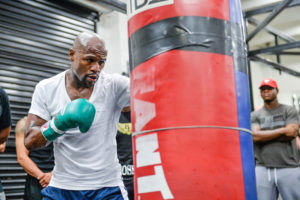You don’t have to be a boxing fan to know that a boxing workout is one of the best ways to get in top shape. And you don’t have to be an aspiring fighter to take the boxing pathway to fitness.
Anyone who has seen any of the “Rocky” movies, or any other boxing movie for that matter, like “Creed” or “Million Dollar Baby,” has seen how a boxing workout doesn’t pull any punches.
Floyd Mayweather has been living proof of the results that can be achieved by someone in boxing shape. Floyd has always espoused “hardwork and dedication” as his mantras, and now he’s brought this experience to the people through his new fitness gym franchise, Mayweather Boxing + Fitness. Floyd’s vision is to make the foundation of boxing training available to everyone on a fitness level, and cardio work is a key part of the program.
What are the essential elements of a boxing workout that yield incredible results for both pros and fans? Let’s review and you can see that what a pro might spend hours on, a fan can accomplish in a modified format as part of a standard 45-60 minute workout routine.
First, there’s cardio. Boxers need to have incredible endurance and stamina. There’s a saying that there’s being in shape, and then there’s being in “boxing shape,” which is a whole different level of fitness.
For cardio, running, known as roadwork, is fundamental. Whatever shape you’re in, assuming you’re healthy enough to work out in the first place, you can get moving and work on your cardio.
Running on a treadmill is ideal for beginners because you don’t take on a distance goal that can be daunting and hard to achieve. Until you’re in great shape, you really don’t know how far you can run. A treadmill allows you to keep track of your distance, and also modify with an incline.
For cardio, a heart-rate monitor is essential equipment. For beginners, you will want your doctor’s clearance on what levels of exertion are appropriate for you. Pros use heart-rate monitors to work on advancing their conditioning for peak performance.
Either way, if you have the data you will be able to assess how hard you are working based on yourself, not comparing yourself to other people. Also, you can make sure you are challenging yourself without overdoing it, and use walking intervals to exert yourself as appropriate for your fitness level too.
Also for cardio, as well as coordination and agility, jumping rope is a key boxing exercise. Jumping rope burns a lot of calories and is tremendous for cardio. Remember that everyone can jump rope as a child, and do it for fun, but for some reason, as we get older, it can seem like a real challenge.
Adding jump rope to your fitness routine will pay real dividends, and you can get started without the rope. Simple jumping jacks, or even modified jumping jacks (a stepping movement without the jump) can start getting you into shape.
If you take up the jump rope, you can begin in shorter intervals, and build stamina over time. And by tripping on the rope, you will give yourself natural breaks and pauses to catch your wind. Over time, you will master the jumping motion and get your coordination back, while at the same time getting in better shape to last longer.
Cardio and conditioning are the foundation of boxing shape, because you can’t last those 3 minute rounds, 10 or 12 of them, unless you’re in tremendous shape. Remember, the boxer who is just trying to survive is probably not the one who is also winning those rounds. Maintaining proper foot-work, balance, and form for power takes even more exertion, stamina, strength, and training.
In our next post, we’ll talk about strength, power and movement — the training that goes into making a boxer explosive, elusive, and dangerous, and can make you get in top-top shape for your life outside the ring.
